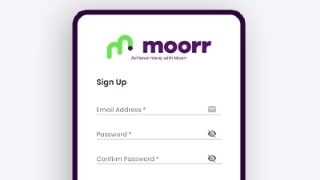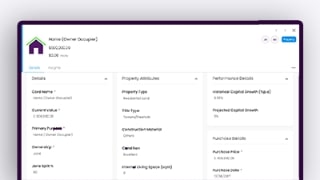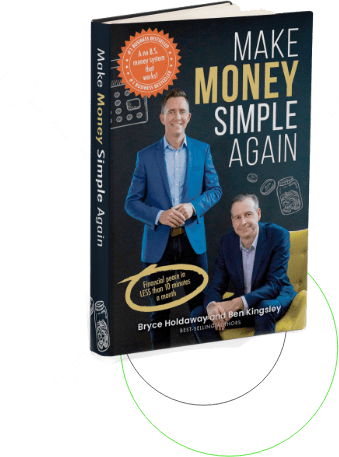Welcome to your guide on building wealth for a brighter financial future!
Whether you want to use the surplus to pay off your mortgage or invest in property, learn how you can make your money work harder for you.
Inspired by Case Study 4 in our best-selling book, “Make Money Simple Again,” this article is packed with useful tips and real-life scenarios to help you in your journey of wealth building.
Don’t miss the opportunity to download the book for FREE and embark on your very own journey to financial freedom.
This article will suit you if you have a healthy monthly income, good monthly surplus, a mortgage and are now thinking about building up your nest egg for retirement. You have two choices: pay down your debt or invest in an additional property.
To start this journey, assess your current financial standing.
You need to find your motivation and use it as your drive moving forward.
The first step toward building wealth is believing in the goal. You must want to achieve this and believe in your ability to achieve financial discipline and self-control.
Once you’re clear with your motivation, you’ll be ready to embrace this change.
If possible, combine your finances by setting up a joint bank account. This will allow your combined money to work harder for you, improving your overall outcome. If you prefer separate accounts, you can still use the MoneySMARTS system with virtual jars to track your surplus amounts.
For this stage, gather your financial documents including payslips, bank statements, and credit card statements. Familiarise yourself on where to look for this information. Is it on an online banking platform? What are your login details? Or is it a paper trail? Do you know where you’ve stored them? Or are they in your email inbox?
By gathering your financial documents, you’ll start to understand your income, savings, assets, and outstanding debts. Identifying your surplus money will be crucial in creating a plan for building wealth.
How can Moorr Help?: Create your free account, log in to Moorr, and follow the prompts. You’ll be asked to enter some numbers. Don’t worry if you don’t know it off the top of your head. Just put in a rough figure, and you can update it once you know for certain.
Organise your financial documents and sort through the numbers. Record your income, savings, assets, and outstanding debts. Having a clear understanding of your finances is essential in crafting a successful wealth-building plan.
How can Moorr Help?: Now that you have the financial documents, update each section in Moorr, particularly the income, assets, and borrowings sections. We’ll work on the expenses next.
Calculate and break down your spending into essential living expenses and discretionary items. Identify your surplus money, which will be crucial in paying down debts or investing. Knowing how much you can allocate to your financial goals is key to success.
How can Moorr Help?: Let’s track your spending!
Once you’ve completed all this, check out your Dashboard in Moorr!
This is the coolest part because it tells you how much surplus you have and more. It’s like a profit and loss statement. If the dashboard shows that you should have a surplus in place, but you don’t, it means you may have overestimated your income or underestimated your expenses/repayments. Make sure to check and update accordingly.
Establish a solid banking setup for successful execution of your plan. Ideally, set up your Primary Bank Account and Living & Lifestyle Bank Account as a 100% offset account on your owner occupier property. And manage your credit card wisely.
If you’re keen to optimise your spending, use the MoneySMARTS virtual Flour Jar categories to calculate your income and expenditure. Identify discretionary spending and areas where you can cut back to increase your surplus income.
Categorise your regular spending, credit card expenses, direct payments, loans, and planned provisions spending. Analyse each category to determine where you can save more and increase your trapped surplus money. Here are some examples:
How can Moorr Help?: Check out our default recommendations!
As you go through Steps 1 to 3, you’ll be amazed at the awareness and understanding you’ve developed about your own money habits. Fascinating, isn’t it? From the very beginning of this journey, we mentioned that having awareness and the correct mindset will help you in the long run. Now, when you look at your Dashboard in Moorr, we hope you’ll clearly see your household’s money in and money out, which will assist you in setting up your banking structure.
Additionally, leveraging on our years of experience in money management and insights from the thousands of users we’ve served, we’ve incorporated our account structure recommendations for each category of bills and spending. Please note that this is a general recommendation based on the fundamentals of MoneySMARTS, and may not be suitable for your unique spending habits. So, feel free to tweak it as you see fit.
Once you’ve reorganised your banking structure, make sure to update them in Moorr!
Commit to your financial transformation and stay motivated. Use Moorr’s Monthly Check Up feature to track your progress and ensure you’re on course towards your financial goals.
How can Moorr Help?: Monthly Checkup!
Monthly check-ups allow you to track and understand your money and cashflow position in a shorter timeframe to give you clearer insights into how well you are progressing and controlling your money. In short, you are assessing the cashflow for the month – money in and money out – and tracking it against your yearly targets.
The great news here is, when set-up and it’s running smoothly, this check-up should take less than 10 minutes a month! To see the full reporting and insights, you only need to input three figures in Moorr:
As you embark on your financial journey, remember that flexibility is key. Be open to adjustments and improvements that will help you reach your goals faster. Increase your surplus money by reducing discretionary spending and stay grounded in reality while working towards your goals. You can refer to Step 4 on some suggestions on how to optimise your spending.
The most important part here is to regularly review your progress and tweak your spending to stay on track. You’re doing great so far, but you can always do better. We’re going to be upfront with you… the first few months of MoneySMARTS are the hardest.
From our data, most users tend to miss out on their unconscious spending. That’s mainly because we’re simply not aware of ALL the money out transactions. But, like any good habit, with time and persistence, it becomes second nature. Soon enough, you’ll be a seasoned MoneySMARTS user, and your money will be on autopilot, saving surplus and preventing unconscious overspending.
Keep at it, and financial freedom will be yours to enjoy!
How can Moorr Help?: The best way to do this is to get a trendline of your spending.
If you notice any of these scenarios:
Review and ask yourself if you can optimise this and get more accurate with your spending and updating Moorr. Stay grounded in reality, but never lose sight of the ultimate goal— living your lifestyle by design. Moorr is here to support you every step of the way, providing the tools and resources you need to succeed.
Review your progress at the end of the year and set new financial goals for the next 12 months. The journey to wealth-building is ongoing, and each year offers a chance for renewal and improvement.
Rollover any surplus money each month to accelerate your savings.
How can Moorr Help?: Annual Rollover
We’ve made it super easy for you to do an Annual Rollover on Moorr! Simply head to the rollover section on the MoneySMARTS page and follow the prompts.
And don’t miss out on all the amazing insights you can get on your dashboard! Here are some suggestions to give you better insights on what you’ve achieved so far and what you can do in the next 12 months:
Once you’ve got a system in place to trap more surplus, what should you do next?
In this section, we’ll explore several scenarios to illustrate the potential impact of your efforts. We’ll assess the different approaches to paying down debt or investing in property and see how it affects your net wealth position and passive income over time.
We’ve got two potential financial outcomes for you – paying off the mortgage or investing in property while paying the minimum off the mortgage. We will be using Moorr’s MoneySMARTS system for both scenarios to forecast their financial future.
This section below is based on the numbers and scenarios in Case Study 4 of our best selling book, Make Money Simple Again. There are heaps more graphs, charts, tables and examples in it so make sure you check it out. It’s free to download!
In this scenario, you will utilise Moorr’s MoneySMARTS system, trapping the Targeted Yearly Surplus to pay off your owner-occupied mortgage. Once the mortgage is paid off, any surplus money will be placed into a high-interest savings account.
In the case study, the couple trapped a Targeted Yearly Surplus of $36,412 to pay off their owner-occupied mortgage quicker and placed the surplus into a high-interest savings account earning 3% interest per year.
In this scenario, you will continue using MoneySMARTS and purchase an investment property. All additional surplus money will be trapped and placed in the Offset Primary Account linked to your owner-occupied mortgage.
In the case study, the couple bought an investment property worth $550,000.
Please note that there are a few assumptions made for the table below. To find out what these assumptions are, download the Make Money Simple Again book below.
Here’s what each scenario turned out for the case study couple based on our simulation:
| Scenario 1: Pay Down Mortgage | Scenario 2: Buy Investment Property |
|---|---|
| Home Mortgage fully offset by Nov 2025 | Home Mortgage fully offset by September 2027. Investment Loan fully offset by August 2033 |
| Net Wealth Position: $6,255,187.89 In Present Day Value Terms: (no inflation of 3%) $3,463,345.87 | Net Wealth Position: $7,510,083.17 In Present Day Value Terms: (no inflation of 3%) $4,158,150.97 |
| Passive Income: ($1,139,954 x 3%) = $34,199 | Passive Income: ($426,657 x 3%) + Rental Income ($67,411) = $80,211 |
If you’ve been enjoying what you’ve read so far, we’re excited to offer you a complimentary copy of “Make Money Simple Again.” Inside, you’ll discover some fantastic charts, graphs, and tables that will make wealth building and retirement planning a breeze.
Whether you’re looking to build wealth and/or plan for a comfortable retirement, this guide has you covered. Just pick the path most relevant to you, and we’ll send the book to you within the next 5 minutes. Let’s embark on the journey to financial security and a worry-free retirement together!
With the power of Moorr’s MoneySMARTS system, conscious spending, and smart choices, you now have the tools to take control of your finances and build wealth for a brighter future.
Stay focused, keep learning, and make informed financial decisions to achieve your financial goals. And always reach out to independent, qualified and experienced advisors to make sure that your banking structure is set up for success, optimised for your unique financial circumstances, and will not hamstring you in your journey toward financial freedom.
Remember, building wealth is a lifelong journey, and with your newfound knowledge and discipline, the possibilities are endless. You have the power to create the life you desire and secure a financially abundant future.
Spend money on the things you want without guilt and save for the future with confidence. You can have the best of both worlds. Achieve more, with Moorr

So much to realise & gain,
nothing to lose.

Onboard with your hopes,
dreams & finances.

Start planning & living your
Lifestyle-by-Design.
*It’s 100% free. No Strings Attached.

So much to realise & gain,
nothing to lose.

Onboard with your hopes,
dreams & finances.

Start planning & living your
Lifestyle-by-Design.
*It’s 100% free. No Strings Attached.
Let's Stay Connected

We only send you awesome stuff =)
This following document sets forth the Privacy Policy for this website. We are bound by the Privacy Act 1988 (Crh), which sets out a number of principles concerning the privacy of individuals using this website.
We collect Non-Personally Identifiable Information from visitors to this Website. Non-Personally Identifiable Information is information that cannot by itself be used to identify a particular person or entity, and may include your IP host address, pages viewed, browser type, Internet browsing and usage habits, advertisements that you click on, Internet Service Provider, domain name, the time/date of your visit to this Website, the referring URL and your computer’s operating system.
Participation in providing your email address in return for an offer from this site is completely voluntary and the user therefore has a choice whether or not to disclose your information. You may unsubscribe at any time so that you will not receive future emails.
Your personal information that we collect as a result of you purchasing our products & services, will NOT be shared with any third party, nor will it be used for unsolicited email marketing or spam. We may send you occasional marketing material in relation to our design services.
If you choose to correspond with us through email, we may retain the content of your email messages together with your email address and our responses.
Some of our advertising campaigns may track users across different websites for the purpose of displaying advertising. We do not know which specific website are used in these campaigns, but you should assume tracking occurs, and if this is an issue you should turn-off third party cookies in your web browser.
As you visit and browse Our Website, the Our Website uses cookies to differentiate you from other users. In some cases, we also use cookies to prevent you from having to log in more than is necessary for security. Cookies, in conjunction with our web server log files or pixels, allow us to calculate the aggregate number of people visiting Our Website and which parts of the site are most popular. This helps us gather feedback to constantly improve Our Website and better serve our clients. Cookies and pixels do not allow us to gather any personal information about you and we do not intentionally store any personal information that your browser provided to us in your cookies.
P addresses are used by your computer every time you are connected to the Internet. Your IP address is a number that is used by computers on the network to identify your computer. IP addresses are automatically collected by our web server as part of demographic and profile data known as traffic data so that data (such as the Web pages you request) can be sent to you.
We do not share, sell, lend or lease any of the information that uniquely identify a subscriber (such as email addresses or personal details) with anyone except to the extent it is necessary to process transactions or provide Services that you have requested.
You may request access to all your personally identifiable information that we collect online and maintain in our database by using our contact page form.
We reserve the right to make amendments to this Privacy Policy at any time. If you have objections to the Privacy Policy, you should not access or use this website. You may contact us at any time with regards to this privacy policy.